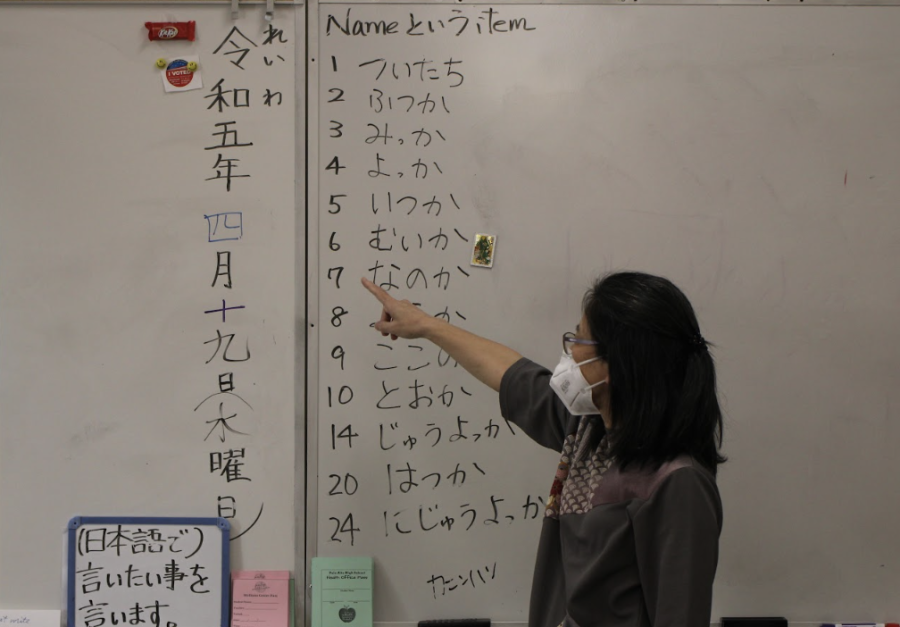Sayonara to Sensei: Japanese teacher to retire at end of year
HUGGING THE MEMORIES — Palo Alto High School’s Japanese teacher Teruko Kamikihara hugs one of her many “Doraemon” plushies. “[Paly] students are friendly and respect each other,” Kamikihara said. “Especially my students. They are really good students.” Photo: Rahul Shetty
Pointing to Hiragana characters on the whiteboard, Palo Alto High School Japanese teacher Teruko Kamikihara sings an upbeat song about Japanese grammar to her students. Colorful posters featuring various animated films cover the classroom walls, filling the room with color and character. However, the spirited decor is not the only thing making Kamikihara’s class so lively; she herself brings a vibrant and welcoming energy to the classroom.
For 22 years, Kamikihara, Palo Alto High School’s only Japanese teacher, has energized her students through singing, dancing and cooking. At the end of this school year, she is retiring in order to travel and relax.
Paly teacher Kevin Duffy, who has known Kamikihara for as long as she’s been teaching, said he admires the effort she puts into her job.
“She is one of the hardest-working people that I know,” Duffy said. “She’s incredibly dedicated to her teaching and to her students.”
Kamikihara, or Sensei to her students, has worked for the Palo Alto Unified School District since 1996, first as a volunteer at Frank S. Greene Jr. Middle School and eventually as a Japanese teacher at both Paly and Henry M. Gunn High School.
She said her passion for teaching started at a young age, and came partly from a desire to carry on her family legacy — both of her parents were teachers during her childhood in Japan.
Many students — including Paly senior Kyle Park — prefer Kamikihara’s creative style to more “traditional” teaching.
“Some of my fondest memories in Sensei’s class are the songs she would sing to get us to remember specific grammatical points,” said Park, who is in her Advanced Placement Japanese class. “Her supportive and cheerful teaching style … helped myself and others learn such a complex language so effectively.”
Kamikihara ensures that every student in her class is celebrated. On each student’s birthday, the whole class sings for them, and they can pick a small gift of Japanese candy or soda that Kamikihara buys with her own money.
“I know them [students] from freshman to senior,” Kamikihara said. “They grow up, so every year we celebrate each person’s birthday. That, I enjoy.”
Prior to the COVID-19 pandemic, Kamikihara used to cook and share meals with her class, and take AP students to the restaurant Sushi House after their AP exam.
According to Kamikihara, a student who decided to continue with Japanese in college once came up to her and told her how the grammar songs kept popping into her head. This is the effect that Kamikihara hopes to inspire in her classes.
“I hope they [the students] remember it [the songs and activities], and at the time, enjoy,” she said.
Her retirement brings mixed emotions to both herself and her students.
“I am 50 percent happy looking forward to my retirement, and 50 percent for [thinking] I [will] miss all my colleagues and students,” Kamikihara said.
The other Paly language teachers have all been able to form strong friendships with her and are sad to see her go.
“When someone who’s been working a long, long, long time reaches their retirement, you’re sad that they’re leaving, but you’re also happy because you want them to be able to enjoy themselves and do some fun things,” Duffy said.
Many students feel the same way. “Knowing that [future students] won’t be taught by her for as long as we were is a sad realization,” Park said. “On the other hand, I am excited for her, as she has been one of the happiest, if not the happiest, teacher I have ever had, and I know that she will make the most of retirement!”



![HUGGING THE MEMORIES — Palo Alto High School’s Japanese teacher Teruko Kamikihara hugs one of her many “Doraemon” plushies. “[Paly] students are friendly and respect each other,” Kamikihara said. “Especially my students. They are really good students.” Photo: Rahul Shetty](https://verdemagazine.com/wp-content/uploads/2023/05/Screen-Shot-2023-05-17-at-2.21.42-PM-894x900.png)
